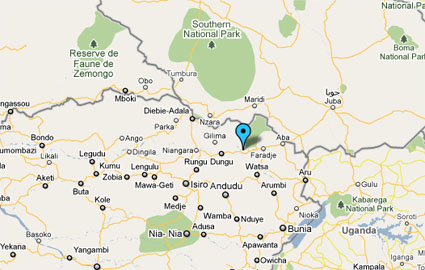Click for full map.
KAMPALA, Uganda – The Ugandan Daily Monitor published today parts of an internal MONUC report which claims that the LRA is returning to Garamba National Park in the Democratic Republic of the Congo. The article states that this development is worrying given the relative proximity of Garamba to the Ugandan border. Arua, the Ugandan town closest to the Congo border, is about 190 miles from Garamba’s southeastern corner.
But the fact that some LRA groups operate in Garamba is not in itself a new development. At least three LRA groups never really left Garamba in the aftermath of Operation Lightning Thunder of December 2008, Enough sources indicate. Aimed at eliminating Kony and other top LRA commanders, the operation consisted of shelling by the Ugandan army, or UPDF, of LRA bases in Garamba, including Camp Kiswahili where Kony was based. Ugandan ground troops arrived at the scene of heavy bombing 48-72 hours later.
Former LRA fighters who have recently come out of the bush say that Kony ordered Major Kalalang, commander of the LRA’s third brigade pre-Operation Lightning Thunder, to stay close to Garamba, according to interviews I have conducted during trips to Congo. Kalalang’s forces eventually split into three smaller groups: one under Lt. Colonel Okot Odek, a second group commanded by Lt. Colonel Charles Arop, and a third group remaining under Kalalang. When Kalalang was killed by the UPDF last summer, Captain Obale took over. Arop, Obale, and many of their fighters had surrendered by the end of 2009 in Djabir, near Garamba.
Odek, one of LRA’s most able commanders, now leads an LRA group of more than 50 fighters and many abductees. The group moves between Dungu and Gangala na Bodio, a small town at the southernmost point of Garamba, 40 miles east of Dungu. According to one former fighter under Odek, his group often camped inside Garamba. Odek’s group is responsible for attacks against civilians in and around Dungu, especially in the village of Bamokandi, right outside of Dungu.
Interviews with former LRA fighters show that Garamba, home to the LRA for at least three years before the December 2008 attack, was regarded by Kony as highly strategic. LRA intelligence squads were ordered to remain behind after the UPDF helicopters shelled LRA bases. “We were told to observe the numbers of UPDF soldiers and their positions,” said a former LRA intelligence officer captured by the UPDF on December 18, 2008.
Caches of guns and ammunition buried in Garamba were the foremost reason why Kony wanted to know about UPDF positions in Garamba. According to Enough sources, the LRA dug out many of the hidden reserves on December 15, a day after the UPDF attack. Taking advantage of the late arrival of UPDF soldiers in Garamba, Kony ordered his fighters to return to their bases and retrieve as much ammunition as possible. Some of the hidden guns were eventually found by the UPDF but many more are still buried. Okot Odek and his fighters operate close to Garamba partly to ensure that the hidden caches in Garamba are safe.
Another troubling reason for the existence of LRA fighters in Garamba, to which the Daily Monitor alludes, might be that Kony and his soldiers plan to return to Uganda via Garamba. At the moment, LRA groups are scattered throughout north-eastern Congo and south-eastern Central African Republic. But all of the groups are highly mobile and very likely in contact with Kony. The possibility that Kony wants to come back to Uganda is high; whether he is capable of returning remains unclear. It is, however, certain that if the UPDF cannot contain or eliminate the LRA, no other military force currently in the region will.


